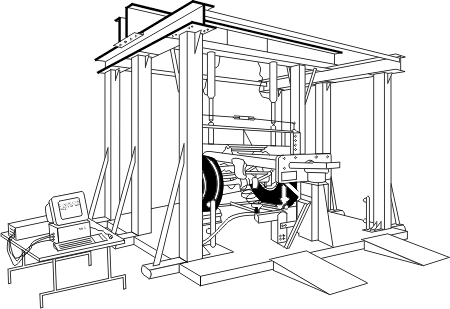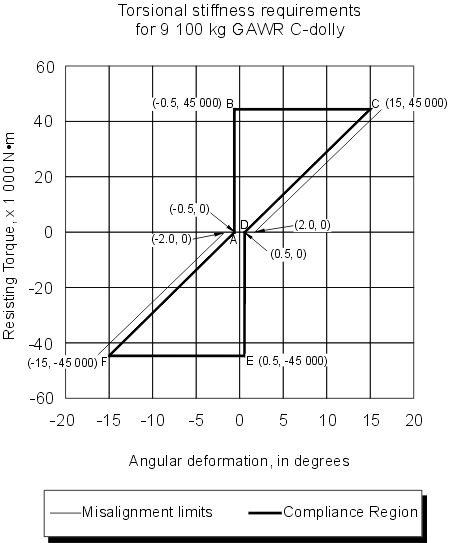|
|
 |
Approved: October 1, 1992

Disclaimer
The documents in HTML format that are provided on this Web site have been
prepared for use as a ready reference and do not have legal force or effect.
A Portable Document Format (PDF) version is provided for the purposes of
interpretation and application. The PDF version may be viewed using version
3.0 or higher of the Adobe® Acrobat Reader, which may be downloaded
free of charge by visiting the Adobe®
Web site. |

TABLE OF CONTENTS
LIST OF FIGURES
|

1.
|
Introduction
Subsections 2 to 6, the Appendices, and Figure 1 of this section make
up test methods referred to in section
903 of Schedule IV to the Motor Vehicle Safety Regulations, to demonstrate
compliance with the requirements of section 903 of Schedule IV of the
said Regulations.
|
(Original signed by)
S. C. Wilson
for the Minister of Transport
Ottawa, Ontario
|
2.
|
Definitions
In this Section,
"angular displacement" means the angular displacement of the fifth-wheel
plate with respect to a transverse line that is
(a) parallel to the horizontal line passing through the centre of
the hitching device or hitching devices, and
(b) located on the vertical plane through the surface to which the
hitching device or hitching devices of the test rig are attached;
"caster offset" means
(a) in the case of an automotive-type steering mechanism, the longitudinal
distance between the centre of tire and the point where the axis of
the kingpin on the same side of the C-dolly intersects the surface supporting
the C-dolly; and
(b) in the case of a turntable-type steering mechanism, the longitudinal
distance between the centre of tire and the turntable axis;
"C-dolly" means a trailer converter dolly that is equipped with
a single axle that is self-steering, and a coupling that is so constructed
that when the dolly is coupled to a towing trailer, it cannot pivot horizontally
with respect to the towing trailer;
"centre of tire" means
(a) in the case of a single tire, any point on the vertical line
bisecting the overall width of the tire and intersecting the horizontal
axis of the tire; and
(b) in the case of dual tires, any point on the vertical line symmetrically
equidistant from the two vertical planes bisecting the overall width
of the tires and intersecting the horizontal axis of the tires;
"drawbar" means a structural member of a full trailer, or trailer
converter dolly that includes a device for the purpose of coupling to
a trailer hitch;
"fifth-wheel" means a coupling device that is mounted on the vehicle
chassis and that consists of a skid plate, associated mounting brackets
and latching mechanism that couples or connects to a kingpin located on
the other vehicle or component, for the purpose of supporting and towing
semitrailers;
"test rig" means an apparatus, including fixtures and instrumentation,
that is designed to apply forces to a C-dolly and to measure forces and
displacements, and that is capable of performing the tests described in
this document;
"trailer converter dolly" means a conversion chassis equipped
with one or more axles, a lower half of a fifth-wheel coupling and one
or two drawbars.
|
3.
|
Vehicle Preparation
3.1 Examine the C-dolly to ensure that it is in a complete and ready-to-run
state of assembly, including tires and hitches.
3.2 Examine the centering force mechanism to ensure that the centering
force mechanism is operating in accordance with the manufacturer's recommendations.
3.3 If the C-dolly has a slider fifth-wheel, set the fifth-wheel trunnion
centre to a position ahead, but no more than 30 mm ahead of the centreline
of the C-dolly.
3.4 Activate and deactivate every locking device to ensure free engagement
and disengagement, and proper alignment of the axle system when locked.
|
4.
|
Test of Steering System
4.1 Connect the C-dolly to the test rig, in accordance with the manufacturer's
recommendation. A typical test rig is shown in Appendix A.
4.2 Connect the centering force mechanism of the C-dolly to an appropriate
source of power supply. For a C-dolly equipped with a pressurized pneumatic
system for the centering force mechanism, connect the pneumatic system
to an air supply line regulated at a pressure of 690 kPa.
4.3 Place frictionless bearings beneath the tires of the C-dolly to
eliminate horizontal forces between the tires of the C-dolly and the test
platform.
4.4 Apply the service brakes on the C-dolly wheels with maximum application
force and maintain the application for the duration of the test.
4.5 Load the C-dolly to its GAWR, by means of a vertical force on
the fifth-wheel.
4.6 Apply a steering moment about the turntable axis in the case of
a turntable-type steering mechanism, or about the kingpin axes in the
case of an automotive-type steering mechanism, until the wheels reach
the limit of their angular range. Measure the total steering moment and
the average steering angle continuously (or at intervals of 0.5 degree
angular displacement of the axle, including measurement of the final displacement).
4.7 Remove the steering moment and measure the average steering angle
at that point.
4.8 Repeat 4.6 and 4.7 for a steering moment in the opposite direction.
|
5.
|
Calculation of Equivalent Forces from Steering Moment
5.1 Record the steering moments measured at a steering angle of one
degree in each direction from paragraphs 4.6 and 4.7.
5.2 Calculate the equivalent lateral force by dividing the steering
moment obtained in 5.1 by the sum of caster offset and 50 mm.
5.3 Calculate the equivalent longitudinal force by dividing the steering
moment obtained in 5.1 by
(a) in the case of an automotive-type steering mechanism, the lateral
distance between the centre of tire and the point where the axis of
the kingpin on the same side of the C-dolly intersects the surface supporting
the dolly; and
(b) in the case of a turntable-type steering mechanism, the lateral
distance between the centre of tire and the turntable axis.
|
6.
|
Test of Torsional Stiffness
6.1 Connect the C-dolly to the test rig, in accordance with the manufacturer's
recommendation.
6.2 Lift the test rig and the C-dolly so that the C-dolly remains
level and its tires are free of the ground. Lock the test rig in this
position for the duration of the torsional test.
6.3 Apply a torque gradually at the hitch points of the C-dolly about
its longitudinal axis until the value of 45,000 N·m is reached. Measure
any initial angular displacement due to slack at the hitch points (i.e.
the initial angular displacement just before the torque exceeds zero value,
see Appendix B). During the application, measure and record the torque
at 0.1 degree intervals of angular displacement of the dolly frame.
6.4 Calculate the torsional stiffness by dividing the torque of 45,000
N·m by the difference between the angular displacement corresponding to
this torque and the initial angular displacement.
6.5 Remove the torsional load and measure any residual angular displacement
at that point (see Appendix B).
6.6 Repeat 6.3 to 6.5 for a torsional load of 45,000 N·m in the opposite
direction.
Appendix A
The following diagram illustrates a facility for testing a trailer converter
dolly equipped with a self-steering mechanism*.
|

Testing Facility
|
*Ref.: "Technical Analysis and Recommended Practice for the Double-Drawbar
Dolly Using Self-Steering Axles", J.H.F. Woodrooffe, P.A. LeBlanc, M.
El-Gindy, December, 1989. A study sponsored by Roads and Transportation
Association of Canada and National Research Council.
Appendix B
Measurement of Residual Angular Displacement (Residual Deformation)
For the purpose of this test method, Figure 1 shows the region in which
the torsional stiffness curve of a C-dolly must lie. Under Section
903 of the Motor Vehicle Safety Regulations, the torsional stiffness
of a C-dolly must be at least 3,000 N·m/degree. Also, the residual deformation
of the C-dolly, following the application and removal of a torque of 45,000
N·m about the longitudinal axis, must not exceed 0.5 degrees. The compliance
region is shown by the polygon ABCDEF formed by bold lines in Figure
1. The two horizontal lines BC and EF are the 45,000 N·m
torque limits. The vertical lines AB and DE are the 0.5
degree limits for maximum allowable residual deformation. Points C
and F represent the angular displacement of 15 degrees
when the torque of 45,000 N·m is reached. The slope of CF, which
passes through the origin, represents the minimum torsional stiffness
of the C-dolly.
For a C-dolly to comply with the torsional stiffness requirements of
CMVSS 903, C-dolly Specifications, any loading and unloading curves (twisting
and un-twisting) must fall within the compliance region ABCDEF.
Theoretically, the loading curve should start at the origin, and the unloading
curve may return to the horizontal axis at some point within 0.5 degrees
of the origin due to hysteresis and hitch slack. But in practice, even
without any hitch slack, there is always some initial non-zero angular
displacement due to manufacturing tolerances. For most C-dolly designs
which have two separate hitches, this misalignment may, when coupled to
a trailer, be as much as 1.5 degrees. To allow for this possible misalignment,
the compliance region in Figure 1 extends 1.5 degrees horizontally in
both directions. The thin lines, which are parallel to DC and AF
and cutting the horizontal axis at 2 degrees, represent the limits for
the compliance region when both initial angular displacement and residual
deformation are considered.
Therefore, if an initial angular displacement is present in a torsional
test, the centre of the compliance polygon should be shifted to the point
of initial angular displacement in order to measure the actual residual
deformations. In other words, the residual deformation must be measured
relative to the point of initial angular displacement. The C-dolly is
considered as non-compliant if an initial angular displacement exceeding
1.5 degrees, or a residual deformation exceeding 0.5 degrees is measured.
For practical purpose, the limit of 1.5 degrees for initial angular displacement
applies to all C-dollies regardless of the design of hitching device.
|

Figure 1
|



